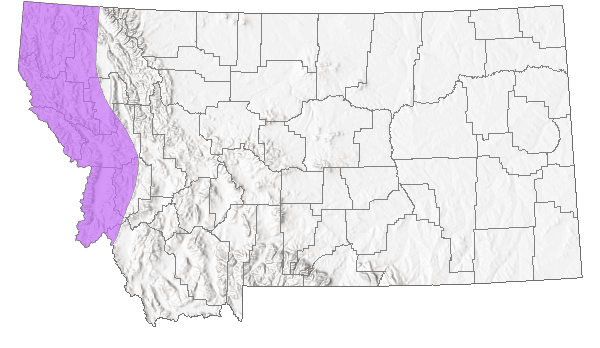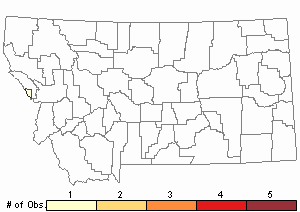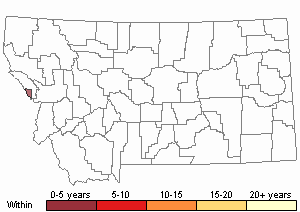View in other NatureServe Network Field Guides
NatureServe
Montana
Utah
Wyoming
Idaho
Wisconsin
British Columbia
South Carolina
Yukon
California
New York
Dispirited Tiger Beetle - Cicindela depressula
Native Species
Global Rank:
G5
State Rank:
S4
Agency Status
USFWS:
USFS:
BLM:
External Links
General Description
The following is taken from Pearson et al. (2015). The body length is 12-16 mm. Coastal individuals tend to be larger than those from montane regions. Color quite variable, especially at higher elevations. Above is brown, green, blue, occasionally black, maculations usually complete but thin, the middle band on elytra typically with a gradual bend toward the midline suture and front portion of the band not concave; below metallic coppery-green to blue.
Phenology
Tiger beetle life cycles fit two general categories. “Spring-fall” beetles emerge as adults in late summer and fall, then overwinter in burrows before emerging again in spring when mature and ready to mate and lay eggs. The life cycle may take 1-4 years. “Summer” beetles emerge as adults in early summer, then mate and lay eggs before dying. The life cycle may take 1-2 years, possibly longer depending on latitude and elevation (Kippenhan 1994, Knisley and Schultz 1997, and Leonard and Bell 1999). Cicindela depressula has a spring-fall life cycle. Adults at lower and coastal elevations are active from April to July and August to October, montane populations early May to early October (Larochelle and Larivière 2001, and Pearson et al. 2015). Adults from Idaho near the Montana border have been reported in August and September (iNaturalist 2023).
Diagnostic Characteristics
The following comes largely from Pearson et al. (2015). This species is most similar to the
Western Tiger Beetle (
Cicindela oregona) which has a middle maculation with a sharp turn or elbow that runs towards the posterior, with front portion of the middle band concave. Two subspecies of
C. depressula are recognized:
C. d. depressula and
C. d. eureka.
C. d. depressula, the montane form, is the subspecies present in Montana. It tends to be smaller than the coastal form and is quite variable above, usually green or blue, but brown or black in some areas of the range.
C. depressula was once considered a subspecies of
C. oregona (Wallis 1961, and Pearson et al. 2015) to which species it is most closely related genetically (Knisley et al. 2008).
Species Range
Montana Range
Range Descriptions

 Native
Native
Range Comments
Cicindela depressula occurs from the coastal regions of northern British Columbia south along the Pacific coast to central California, and in the interior mountains from the Cascades south through the Sierra Nevada and across southern British Columbia to the Rocky Mountains, then south along the northern Idaho and Montana border. Status in Montana is uncertain, but reports from Idaho, in Idaho County (Shook 1984) and more recently in Clearwater County (iNaturalist 2023), some of which are on the border with Mineral County, Montana (Kristi Dubois personal communication 2023), indicate this species is likely present in the area of Montana depicted by the current range map (Pearson et al. 2015). Additional survey coverage in that area is desirable.
Observations in Montana Natural Heritage Program Database
Number of Observations: 1
(Click on the following maps and charts to see full sized version)
Map Help and Descriptions
Relative Density

Recency



 (Observations spanning multiple months or years are excluded from time charts)
(Observations spanning multiple months or years are excluded from time charts)
Migration
Non-migratory but capable of dispersal. When wings fully developed (macropterous), it is a strong flier and fast runner (Larochelle and Larivière 2001).
Habitat
Adult and larval tiger beetle habitat is essentially identical. The larvae live in soil burrows (Knisley and Schultz 1997). Habitat for Cicindela depressula includes coastal riparian habitats, riverbanks and river bars (C. d. eureka), grasslands, alpine meadows, forest clearings, roads and road cuts, trails and parking lots (C. d. depressula), on ground composed of sand, loam, clay, or gravel that is open, bare or sparsely vegetated and sometimes wet. Found up to at least 9850 ft (3000 m) elevation in California, sometimes in disturbed areas formed by melting snow, recent wildland fire, and logging, as well as above treeline in alpine terrain (Larochelle and Larivière 2001, and Pearson et al. 2015). Habitat in Montana not described.
Food Habits
Larval and adult tiger beetles are predaceous. In general, both feed considerably on ants (Wallis 1961, and Knisley and Schultz 1997). The diet of Cicindela depressula is not described (Larochelle and Larivière 2001) but probably small insects and spiders.
Ecology
Larval tiger beetles live in burrows and molt through three instars to pupation. Adults make shallow burrows in soil for overnight protection, deeper burrows for overwintering. Adults are sensitive to heat and light and are most active during sunny conditions. Excessive heat during midday on sunny days drives adults to seek shelter among vegetation or in burrows (Wallis 1961, and Knisley and Schultz 1997).
Cicindela depressula depressula has a wide range of ecological tolerance (eurytopic) as evidenced by the variety of habitats in which it occurs, whereas
C. d. eureka has a narrow range of ecological tolerance (stenotopic). Adults are diurnal and solitary to gregarious. They are inactive on overcast and rainy days at higher elevations (Pearson et al. 2015). Predators on adults are not reported, but robber (asilid) flies and birds are likely. Escapes by flying quickly for some distance, and also produces a defensive secretion to deter predators. Other associated tiger beetle species include
C. longilabris and
C. oregona (Larochelle and Larivière 2001).
Reproductive Characteristics
Mating is not reported but presumably throughout period of adult activity in early May to early October for C. d. depressula, April to July and August to October for C. d. eureka (Larochelle and Larivière 2001, and Pearson et al. 2015). Mating pairs of C. d. depressula photographed early July to mid-August (iNaturalist 2023). Larval burrows of C. d. depressula are clustered in melted snowpack swales in patches of bare soil among low alpine vegetation at 9850 ft (3000 m) in the Sierra Nevada Mountains of California. Larval biology of C. d. eureka is not described (Pearson et al. 2015).
Management
Not considered rare or in need of special conservation management (Knisley et al. 2014). Management needs are hindered somewhat by a general lack of information or survey effort for this species. Response to wildfire disturbance, increasingly a land management issue at higher elevations in the western mountains, remains unknown. Local disturbance could also be a problem for some populations where larval burrows are damaged or destroyed by trampling from livestock, but grazing at appropriate times and stocking levels could also be beneficial by keeping vegetation cover more open (Knisley 2011).
Stewardship Responsibility
References
- Literature Cited AboveLegend:
 View Online Publication
View Online Publication Dubois, K. 2023. Personal communication re: Cicindela depressula iNaturalist records in Idaho.
Dubois, K. 2023. Personal communication re: Cicindela depressula iNaturalist records in Idaho. iNaturalist. Research-grade Observations. Accessed 5 November 2023. https://www.inaturalist.org/
iNaturalist. Research-grade Observations. Accessed 5 November 2023. https://www.inaturalist.org/ Kippenhan, Michael G. 1994. The Tiger Beetles (Coleoptera: Cicindelidae) of Colorado. 1994. Transactions of the American Entomological Society 120(1):1-86.
Kippenhan, Michael G. 1994. The Tiger Beetles (Coleoptera: Cicindelidae) of Colorado. 1994. Transactions of the American Entomological Society 120(1):1-86. Knisley, C.B. 2011. Anthropogenic disturbances and rare tiger beetle habitats: benefits, risks, and implications for conservation. Terrestrial Arthropod Reviews 4:41-61.
Knisley, C.B. 2011. Anthropogenic disturbances and rare tiger beetle habitats: benefits, risks, and implications for conservation. Terrestrial Arthropod Reviews 4:41-61. Knisley, C.B., and T.D. Schultz. 1997. The biology of tiger beetles and a guide to the species of the south Atlantic states. Virginia Museum of Natural History Special Publication Number 5. 210 p.
Knisley, C.B., and T.D. Schultz. 1997. The biology of tiger beetles and a guide to the species of the south Atlantic states. Virginia Museum of Natural History Special Publication Number 5. 210 p. Knisley, C.B., M. Kippenhan, and D. Brzoska. 2014. Conservation status of United States tiger beetles. Terrestrial Arthropod Reviews 7:93-145.
Knisley, C.B., M. Kippenhan, and D. Brzoska. 2014. Conservation status of United States tiger beetles. Terrestrial Arthropod Reviews 7:93-145. Knisley, C.B., M.R. Woodcock, and A.P. Vogler. 2008. A new subspecies of Cicindela limbata (Coleoptera: Cicindelidae) from Alaska, and further review of the maritima group by using mitochondrial DNA analysis. Ann. Entomol. Soc. Am. 101(2):277-288.
Knisley, C.B., M.R. Woodcock, and A.P. Vogler. 2008. A new subspecies of Cicindela limbata (Coleoptera: Cicindelidae) from Alaska, and further review of the maritima group by using mitochondrial DNA analysis. Ann. Entomol. Soc. Am. 101(2):277-288. Larochelle, A and M Lariviere. 2001. Natural history of the tiger beetles of North America north of Mexico. Cicindela. 33:41-162.
Larochelle, A and M Lariviere. 2001. Natural history of the tiger beetles of North America north of Mexico. Cicindela. 33:41-162. Leonard, Jonathan G. and Ross T. Bell, 1999. Northeastern Tiger Beetles: a field guide to tiger beetles of New England and eastern Canada. Boca Raton, FL: CRC Press. 176 p.
Leonard, Jonathan G. and Ross T. Bell, 1999. Northeastern Tiger Beetles: a field guide to tiger beetles of New England and eastern Canada. Boca Raton, FL: CRC Press. 176 p. Pearson, D.L., C.B. Knisley, D.P. Duran, and C.J. Kazilek. 2015. A field guide to the tiger beetles of the United States and Canada, second edition. New York, NY: Oxford University Press. 251 p.
Pearson, D.L., C.B. Knisley, D.P. Duran, and C.J. Kazilek. 2015. A field guide to the tiger beetles of the United States and Canada, second edition. New York, NY: Oxford University Press. 251 p. Shook, G.A. 1984. Checklist of tiger beetles from Idaho (Coleoptera: Cicindelidae). Great Basin Naturalist 44(1):159-160.
Shook, G.A. 1984. Checklist of tiger beetles from Idaho (Coleoptera: Cicindelidae). Great Basin Naturalist 44(1):159-160. Wallis, J.B. 1961. The Cicindelidae of Canada. Toronto, Ontario, Canada: University of Toronto Press. 74 p.
Wallis, J.B. 1961. The Cicindelidae of Canada. Toronto, Ontario, Canada: University of Toronto Press. 74 p.
- Additional ReferencesLegend:
 View Online Publication
View Online Publication
Do you know of a citation we're missing? Bousquet, Yves. 2012. Catalogue of Geadephaga (Coleoptera; Adephaga) of America north of Mexico. ZooKeys. 245:1-1722.
Bousquet, Yves. 2012. Catalogue of Geadephaga (Coleoptera; Adephaga) of America north of Mexico. ZooKeys. 245:1-1722. Pearson, D.L., C.B. Knisley, and C.J. Kazilek. 2006. A field guide to the tiger beetles of the United States and Canada: identification, natural history, and distribution of the Cicindelidae. Oxford University Press, New York, New York. 227 pp.
Pearson, D.L., C.B. Knisley, and C.J. Kazilek. 2006. A field guide to the tiger beetles of the United States and Canada: identification, natural history, and distribution of the Cicindelidae. Oxford University Press, New York, New York. 227 pp.
- Web Search Engines for Articles on "Dispirited Tiger Beetle"
- Additional Sources of Information Related to "Insects"





